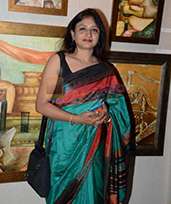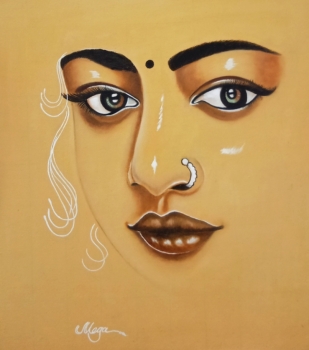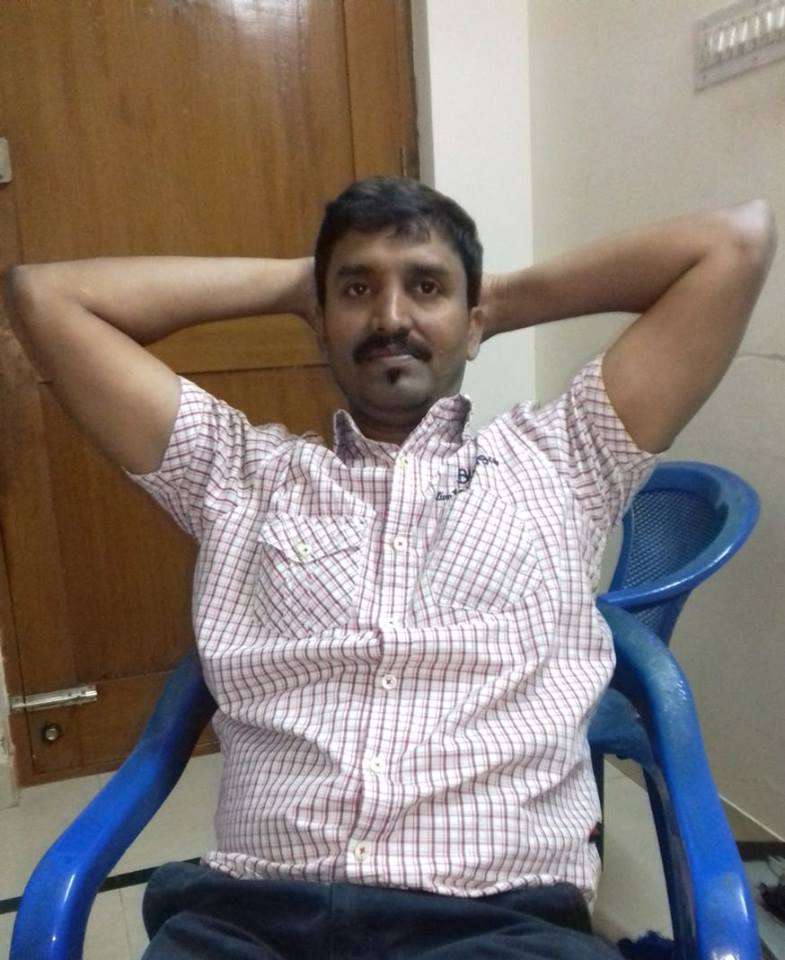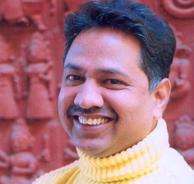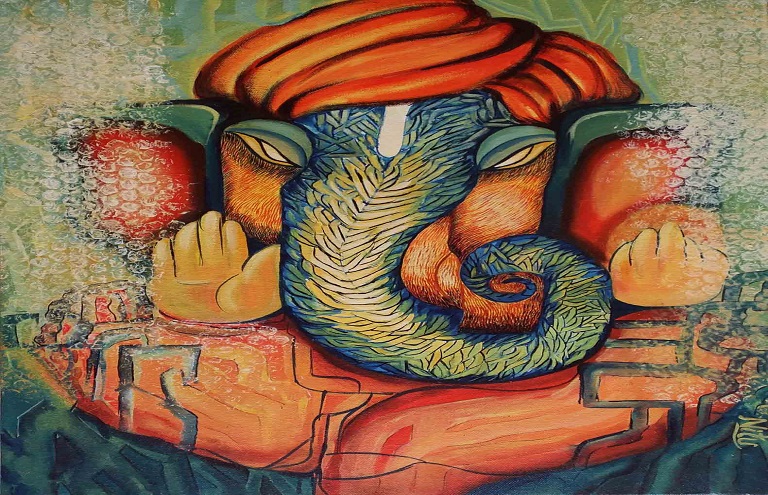
Gorgeously decorated pandals, scrumptious modaks, sumptuous food, and gorgeous festive wear— indeed the favorite time of the year once again! It is Ganesh Chaturthi, time to welcome our beloved Ganesha to our homes. Also, known as Vinayaka Chaturthi, this auspicious festival is dedicated to Lord Ganesha (son of Shiva and Parvati), the elephant-headed God of good beginnings, wealth, wisdom and success. Celebrated for 10 days every year in the Bhadra month as per the Hindu calendar, this festival marks the birthday of the beloved elephant-headed Lord Ganesha. Though it is celebrated with great devotion and joy by Hindus throughout the country including the states of Maharashtra, Gujarat, Goa, Madhya Pradesh, Karnataka, and Telangana, the fervor, grandeur, and splendor in the streets of Mumbai are larger-than-life— bustling with devotees and festivities. But whether you can be a part of the colorful Ganpati celebrations in Mumbai or not, in these times of the pandemic we suggest you enjoy the festival by indulging in mesmerizing Ganesha paintings and artworks. So here we bring to you some splendid artwork of Lord Ganesha that will bring color and happiness, also give you strength and bless you in these tough times.
1. Lord Ganesha and Mata Parvati
Hussain’s splendid repertoire is rich in its depiction of Hindu deities which clearly displays his fascination for Hindu mythology. And like many other paintings Husain, Lord Ganesha and Mata Pravati (image below) turned out to be controversial which lured severe criticism. It was a part of an exhibition made up of 75 works of Husain on display at the JW Marriott hotel in Mumbai. The painting showed Lord Ganesha in the lap of his mother, Parvati. However, one of the guests at Marriott took the painting as an offense and incensed by the fact that God was portrayed alongside a semi-nude woman who submitted a letter of objection to the hotel's management. Following the complaint, the painting had to be removed from an exhibition held at the hotel as the exhibitors - Delhi Art Gallery feared severe protest and violence erupting and the painting is damaged. But as a true art lover, you cannot but help to fall in love with this breath-taking masterpiece of MF Husain.
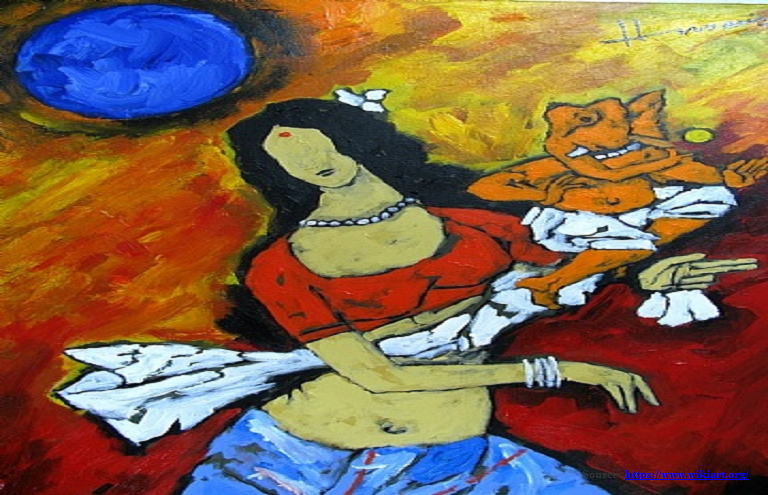
2. Ganesha Playing Tanpura
Another popular Ganesha painting of Husain where he gives the elephant-headed God a special and prominent place. In this colorful painting, Ganesha is represented as playing the famous Indian string instrument, Tanpura with a pair of twin hand drums (Tabla) kept in the background. A vibrant patchwork of colors surrounds the string and percussion instrument, giving the beloved deity and his music a sense of motion, viability, and life. Husain’s fascination with music and his effort to give his art a sense of musicality is clearly evident in this painting.

This visually pleasing painting is a part of the popular series of Husain on Lord Ganesha.
3. Dancing Ganesha
This sculpture of dancing Ganesha carved from the sandstone over a thousand years ago is housed at the Philadelphia Museum of Art. As per experts, it was probably placed in the south exterior wall of a temple in the city of Gwalior in north-central India.
The beloved deity is portrayed in his traditional form with four arms and embellished with jewelry, anklets, and bracelets. His dancing body seems to be in a graceful bend similar to ‘S’ curves, his upper-right hand points to his swaying trunk, and his lower-left armrests on his lower body. In his lower-right hand, he can be seen holding a large battle-axe to protect his worshippers from trouble while in his upper-left hand he grasps a cone-shaped object that has been interpreted in many ways — it might be his broken tusk, a shell or a daikon (large white radish) which is considered a great treat for elephants.
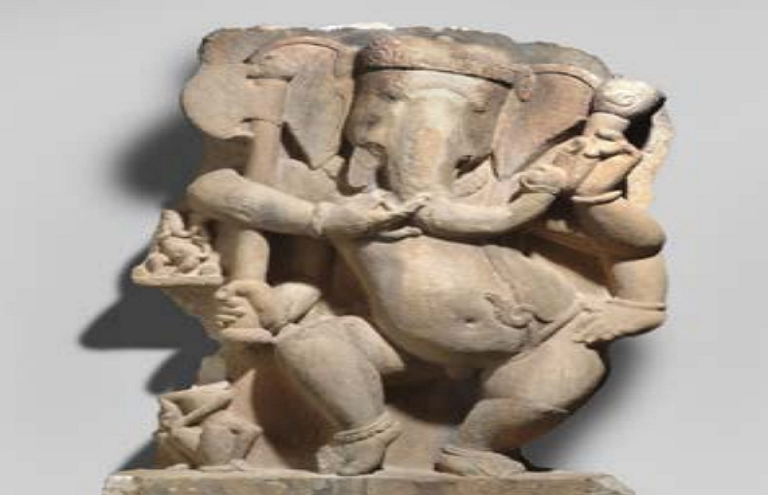
4. Blue-eyed Ganesha
Russian-American artist Mila Kronik has created this enthralling Ganesha painting (image below) depicting him with deep blue eyes and copper trunks. The colors used and the details added are so hypnotizing that it is difficult to take one's eyes off this painting.
Born in Russia, Kronik went seeking her spiritual path at the age of 27. Her search connected her to the ancient Vedic tradition of bhakti-yoga and she came to India to study the subject. Spending 6 months in India helped her absorb the Vedic literature and its traditions. Meanwhile she also went on pilgrimages and gathered content for her art, which changed her life drastically and hence is the primary inspiration for many of her paintings. She attempts to reflect her spiritual experiences, devotion, practice of yoga and divine in nature in her works.

5. Tribute of Lord Ganesha
On the occasion of Ganesh Chaturthi in 2019, Padma awardee sand artist Sudarsan Pattnaik created a massive 10-ft high sculpture of Lord Ganesha using 5 tonnes of sand at Puri beach. With around 1000 plastic bottles installed around it, this sculpture aims at generating awareness against single-use plastic to save the environment.
He took inspiration from Prime Minister Narendra Modi's campaign to stop single-use plastic in his Mann Ki Baat radio broadcast on his address to the nation on the 73rd Independence Day.
The creation by the renowned Odisha artist is aimed at making people aware of the adverse effects of plastic on the environment. If not recycled, plastic takes up to a thousand years to decompose thereby creating severe health hazards.

“On the occasion of Ganesh Chaturthi, I want to appeal to the people not to use single-use plastic to save our environment” — Sudarshan Pattnaik
The renowned artist has represented India in more than 60 international sand sculpture championships as well as popular festivals around the world and won many prizes. Most of his sand creations are based on crucial social issues aimed at generating awareness in society around, which are real pieces of beauty that we cannot stop admiring.
Read More: Deciphering Lord Ganesha: An artistic perception
Having explored these mesmerizing artworks must have inspired the artist in you, why don’t make this auspicious occasion more enjoyable by trying your hands on making your own Ganesh ji sketch. We have compiled a simple guide to help you get started:
Step1: Start with a piece of paper having an almost similar length and width (or draw a faint square-shaped box on your paper for reference). Next, using a pencil draw properly all your reference shapes — a circle for Ganesha's torso, a smaller circular shape above it for the head, and two sausage-shapes immediately below the bigger circle for his crossed legs.
Step 2: Carefully add Ganesha's face, trunk, and ears with bold, cleaner lines. You can use the torso's circle drawn before as a guide for placement of the trunk and ears.
Step 3: It’s time to add in the crown details, and work further on the ears. You will probably find it easier as working on smaller features has less open space to overwhelm you than the bigger ones as it offers more area and so the confusion.
Step 4: Now, fill in the neck details, and then outline his torso — and don't forget his adorable love handles while working on his protruding round belly! Once done, you will find that the two-dimensional depiction of Ganesha is starting to come along now.
Step 5: It's time to work on his crossed legs, create two ovals and work in a manner that depicts the deity in sitting posture, don’t forget to add in the foot and the related details. Next, work on his two arms,— the first right hand is usually seen holding a lotus while the left one has a lotus, which is the symbol of enlightenment and reality.
Step 6: Next, draw the three remaining hands of the deity. Sketch it in a manner with the extra hand on right raised open in blessing and the other on left having his favorite modak, he is well-known for his fondness of sweets. The last hand holds a hatchet, or axe, representing cutting away of worldly attachment when enlightened. While these are the traditional objects Ganesha is usually seen with, you can also portray him holding items such as a shell, pasha (or noose), and elaborate his broken tusk.
Step 7: Time to embellish the deity with jewelry. Adorn him with a necklace or two elaborating the finer details. You can also place beads on the hems of his dhoti. Make sure it’s done with more precision so that it elevates your work beyond a simple line drawing.
Step 8: Now, fill in the facial features of Ganesha, draw the eyes, the tilak on the forehead, and add little details on the trunk.
Step 9: With all the details in place, it’s time to drape Ganesha in a coat, finish strong with these waving coattails.
Step 10: Finally, finish the Ganesh pencil sketch in bold with a marker. Trace every line and feature carefully with extreme precision with a black marker, and your sketch is ready! You can skip this step, if you prefer working in graphite or charcoal only, this medium has its own beauty.
Don’t forget to share your Ganesh ji sketch in the comments section below. Happy Ganesh Chaturthi!











